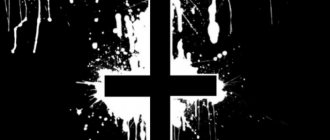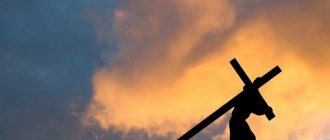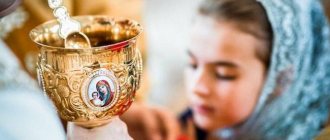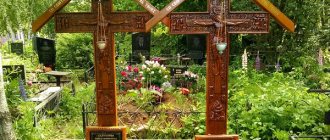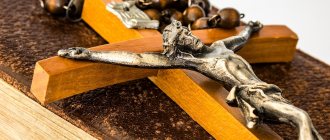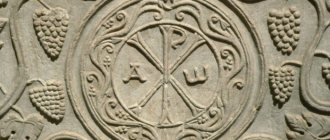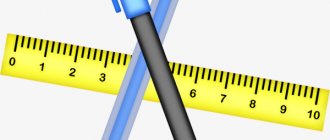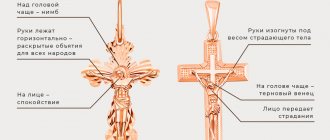Installation of a worship cross
An example of a missionary cross can also be considered the cross of St. Olga, placed on the banks of the Velikaya River near Pskov, in the place where the holy princess and her companions saw three heavenly rays converging on the earth. And also the cross of St. Stephen of Perm at the site of his first sermon to the Perm people.
The custom of erecting worship crosses on Russian soil dates back to ancient times. Our Orthodox ancestors, having a strong faith, knew about the meaning and importance of installing worship crosses in this temporary life and for the salvation of their souls and their neighbors in eternity. Therefore, worship crosses were placed at special memorable places, at crossroads, not far from villages and hamlets, so that, setting off on a journey or entering a village, a person would ask for mercy and help or offer a prayer of gratitude to the Lord and heavenly intercessors.
Such crosses were called roadside crosses, boundary crosses, and were installed near roads so that travelers could pray and ask for God’s blessing. Nowadays, it has become a tradition to consecrate dangerous sections of roads by installing a worship cross. Such crosses marked the entrance to a city or village, as well as the boundaries of agricultural land. Roadside crosses in the Russian tradition often had a “roof” of two planks, and sometimes a case with an icon and a lamp or candle inside and were called “cabbage rolls.”
Sometimes they put up a cross as a result of a vow, for example, at the birth of an heir or on the occasion of an important event in the life of the family, and such crosses in Rus' were called votive crosses. For example, not far from Pereyaslavl-Zalessky there is still a chapel built as a canopy over a votive cross, which, according to legend, was erected by Tsar Ivan the Terrible in memory of the birth of the heir Theodore in 1557.
The vow to erect a cross of worship could be made by the entire village, for example, on the occasion of Heavenly intercession during epidemics, loss of livestock, drought and other troubles and misfortunes. Crosses were also placed in honor of saints revered in the area, church holidays, and significant events in the life of the country and the ruling family. With the erection of the cross, the desert dwellers began their hermit life, and very often a monastery was later formed on this site.
This is evidenced by the wooden and stone worship crosses that have survived to this day in Russia. Orthodox worship crosses are most often found in wood, less often - stone four-pointed or cast. They can be decorated with carvings and ornaments. Their Orthodox content and orientation to the east remain unchanged. Stones were usually placed at the foot of the Cross to create a small elevation, which symbolizes Mount Golgotha, on which Jesus Christ was crucified. Participants in the event placed a handful of earth they carried with them from their threshold under the base of the Cross.
The peasant culture of the Northern Volkhov region is characterized by the presence of a large number of wooden crosses of the 17th-19th centuries. The earliest of them are a cross of 1625 from the village of Bor and a cross of 1626 from the village of Nevazha.
These monuments attracted almost no attention from researchers of the region; at the same time, they are quite informative - both due to the inscriptions preserved on them, and in connection with their functions in folk culture. Thus, many wooden crosses contain inscriptions ordering the celebration of certain holidays: “To celebrate the holiday of the All-Merciful Lord God the Savior Jesus Christ and the Holy Great Martyr of Christ George” “To celebrate the Venerable Father Sergius of Radonezh.”
In addition, on most crosses it is indicated by whose “command” they were placed: “This Holy and Life-Giving Cross of the Lord was placed for worship by Orthodox Christians by the command of the servant of God Vasily Simanovich and his son Mikhail Vasilyevich Zheltukhin 7196 (1688) August on the 5th day.”
The cross is placed on some occasion that is tied to a historical date, an event in spiritual life, and it is necessary to reflect this not only with text, but also with a cross image. The meaning is supported, filled and accentuated by the hierarchy of names, symbolic signs, and so on.
Crosses erected in memory of any significant events that played an important role in the life of Orthodox Christians are also revered in Russia; such crosses are called memorial crosses. Let's list the most famous of them.
The Ignach cross dates back to 1238 - a sign in the form of a cross, standing at the turning point of Batu’s invasion from Novgorod. In 1352, Prince Boris Konstantinovich of Suzdal built the church of the Spaso-Efimiev Monastery, and St. John erected a wooden cross here. Around 1359, the cross of St. Stephen of Makhrishchi was also built.
In 1371, at the founding of the Prilutsky Monastery near Vologda, the Monk Demetrius erected a wooden cross; Around 1380, Saint Stephen of Perm erected a wooden cross and a chapel on the site of his first sermon to the Zyryans.
Another noteworthy cross is from the 17th century, which was made and placed by Peter I in Unskaya Bay on the White Sea coast as a sign of salvation during a storm on June 2, 1694, when he visited the Solovetsky Monastery.
READ How to set a password for Wi-Fi d link 2640u
Peter I himself carved the following inscription on the cross: “This cross was erected by Captain Peter in the year of Christ 1694.” After this, the unique historical monument changed its location several times: in the 18th century, the cross “behind rotting” was moved to the Assumption Church of the Pertominsky Monastery. At the request of the residents of Arkhangelsk and with the permission of Emperor Alexander I, in 1805 the cross was transported with all honors to the Trinity Cathedral of Arkhangelsk.
In the northern regions, crosses often served as navigational signs (the upper end of the inclined crossbar pointed exactly to the north); information about them was contained in sea directions. Such crosses were called noticeable and served as a guide for sailors, therefore they reached a height of 10-12 m.
There is a tradition in Rus' of erecting funeral crosses, which do not always coincide with the burial place of a Christian, but are placed at the site of his sudden death; in our time they can often be seen along the roads.
The tradition of erecting worship crosses is being revived in Russia. Today they are placed at the entrance to cities, on the site of destroyed churches, on hills, in memory of victims of repression, along highways at accident sites, and even in honor of the creators of the T-34 tank.
In 2003, in the village of Sholokhovo near Moscow, near the Museum of the T-34 tank, a worship cross was erected in honor of the designers of the tank and all its combat crews. Prayers and memorial services are held near it.
In May 1994, in memory and honor of St. Cyril and Methodius, Slavic teachers, a memorial four-pointed stone cross was installed and consecrated on a pedestal at the intersection of Pushkinskaya Street and Universitetsky Lane in Rostov-on-Don, in a small park. The author of this monument is Moscow sculptor Vyacheslav Klykov. Every year on May 24, the Orthodox Church and the entire Slavic world honors the memory of Saints Equal-to-the-Apostles Cyril and Methodius, the creators of Slavic writing.
The worship cross is a spiritual shield from all enemies, visible and invisible. Many large cities in Russia are fenced on four sides with protective crosses.
All worship crosses, having different memorable and significant meanings, first of all, serve as a place for believers to pray and worship our Lord and God Jesus Christ.
Source
How to choose a cross for a monument
There were and are a huge number of crosses in the world: the ancient Egyptian Ankh, the Celtic cross, the solar, Latin, Orthodox, Byzantine, Armenian (“blooming”), St. Andrew’s and other crosses - these are all geometric symbols used in different eras and in modern times to express different meanings. Most crosses are somehow connected with Christianity.
In the Christian tradition, the veneration of the cross originates from the legend of the martyrdom of Jesus Christ. Execution by crucifixion existed before Christ - this is how robbers were usually crucified - however, in Christianity, the cross takes on the meaning not only of an instrument of execution, but of the salvation of Christians through the death of Jesus.
To decide on the choice of a monument in the form of a cross, you need to understand the difference between their different types. Considering that the majority of Belarusians identify themselves with Christianity, we will dwell in more detail on the types of Christian crosses used on the territory of Belarus.
“The cross is the main Christian symbol. Worshiping the image of the cross, we see in it, first of all, the symbol of Christ Himself and the symbol of the way of the cross that He commanded us: “If anyone wants to come after Me, deny himself, take up your cross, and follow Me.” The appearance of the cross also points to the mystery of the Trinity: with its vertical line it points us to the Most High Father, with its transverse crossbar - to the Son and the Holy Spirit, for David says: “Thy hands made me, and will create me, that is, the Son and the Holy Spirit created.” Mokeev G.Ya., Kudryavtsev M.P. About a typical Russian church of the 17th century. // Architectural heritage. 1981. No. 29. pp. 70–79
The crescent on the Orthodox cross, or, to call it correctly, the tsata, symbolizes the symbol of the Lord Jesus Christ as King and High Priest. The placement of a cross with a tsata on the dome of the cathedral reminds Orthodox believers that this temple belongs to the King of kings and the Lord of lords. The crescent moon, as an element of church utensils, symbolizes the rank of the Kingdom and the high priesthood. The crescent on the Orthodox cross has nothing to do with Islam or some kind of victory over Muslims. Orthodox crosses with a crescent tsata were placed on ancient churches... It should be noted that the crescent was the state sign of Byzantium - in Orthodox Byzantium the tsata symbolized royal power. Apparently, this is why the tsata is placed on the image of the Kyiv prince Yaroslav Izyaslavich in the “Royal Chronicler” of the 16th century as a symbol of grand-ducal dignity.
In addition, in the patristic tradition there are other meanings of the crescent on the Orthodox cross. For example: the Bethlehem cradle that received the Infant Christ, the Eucharistic cup in which the Body of Christ is located, the church ship, the baptismal font...
The Byzantine shape of the head is a hemisphere - an image of the even radiance or light of God descending from heaven onto us. The image of the flame is our prayerful burning towards God and the Divine fire overshadowing us. In the work “Primordial Essence” A.F. Losev, based on the works of the holy fathers of the Church, concludes that a ball, a sphere is “a symbolic image of the existence of ethereal forces.” And Nikolai Troitsky says: “The world of ethereal forces surrounds the primary center of existence with concentric spheres located in accordance with the hierarchy of angelic ranks,” Troitsky N.I. Iconostasis and its symbolism // Orthodox Review. 1891. Book. 4 The helmet-shaped form is characteristic of the period of the Horde yoke. The poppies resemble a military helmet. — in the city of Wologda, Vologodskaya Oblast', Russia.
Varieties of Christian crosses
In the early Christian Eastern Church, about 16 types of crosses were common. Each of the crosses is revered by the church, and, as the priests say, a cross of any shape is as holy as the tree on which the Savior was crucified.
The most common types of crosses in Belarus:
- Six-pointed Russian Orthodox cross
- Eight-pointed Orthodox (cross of St. Lazarus)
- Eight-pointed cross - Golgotha
- Four-pointed Latin (or Catholic). Alternatively, this is also an Orthodox cross.
What is the difference between these crosses?
Six-pointed Russian cross
The six-pointed Russian cross is a cross with one horizontal crossbar and a lower inclined one.
This form of the cross exists in Orthodoxy along with the eight-pointed one, being, in fact, its simplified form. However, it should be noted that the spread of this type of cross is more typical for Belarus. In Russia, you can find an eight-pointed Orthodox cross much more often.
The lower crossbar of the six-pointed Russian cross symbolizes the footrest, a detail that took place in reality.
The cross on which Christ was crucified was four-pointed. Another crossbar at the feet was attached to the cross before placing the cross in a vertical position, after the crucifixion, when the place on the cross where the feet of the crucified person were located became obvious.
The inclination of the lower crossbar has the symbolic meaning of “the measure of righteousness.” The higher part of the crossbar is located on the right side. At the right hand of Christ, according to legend, a repentant and therefore justified thief was crucified. On the left side, where the crossbar faces down, a robber was crucified, who by blaspheming the Savior further aggravated his situation. In a broad sense, this crossbar is interpreted as a symbol of a person’s state of mind.
Eight-pointed cross
The eight-pointed cross is a more complete form of the Orthodox cross.
The upper crossbar, which distinguishes the cross from the six-pointed one, symbolizes the tablet with the inscription (title), which was nailed to the cross also after the crucifixion, by order of Pontius Pilate, the Roman prefect of Judea. Partly in mockery, partly to indicate the “guilt” of the crucified man, the tablet read in three languages: “Jesus of Nazareth, King of the Jews” (I.N.C.I.).
Thus, the meaning of the six-pointed and eight-pointed crosses is the same, but the eight-pointed cross is more rich in symbolic content.
Eight-pointed cross-Golgotha
The most complete type of Orthodox cross is the Golgotha cross. This symbol contains many details that reflect the meaning of Orthodox doctrine.
The eight-pointed cross stands on a symbolic image of Mount Golgotha, on which, as it is written in the Gospel, the crucifixion of Christ took place. To the left and right of the mountain are the letter signatures of G.G. (Mount Golgotha) and M.L. R.B. (Place of Execution Crucified Byst or, according to another version, Place of Execution Paradise Byst - according to legend, at the site of the execution of Christ there was once Paradise and the forefather of humanity, Adam, was buried here).
Under the mountain there is a skull and bones - this is a symbolic image of the remains of Adam. Christ “washed” his bones with his blood, saving humanity from original sin. The bones are arranged in the order in which the hands are folded during communion or burial, and the letters G.A. located near the skull indicate the words Head of Adam.
To the left and right of the cross are depicted the instruments of Christ’s execution: on the left is a spear, on the right is a sponge with the corresponding letter signatures (K. and G.). According to the Gospel, a warrior brought a sponge on a cane, soaked in vinegar, to Christ’s lips, and another warrior pierced his ribs with a spear.
Behind the cross there is usually a circle - this is the crown of thorns of Christ.
On the sides of the cross of Golgotha there are inscriptions: Isa. Xs. (short form of Jesus Christ), King of Glory, and Ni Ka (meaning Conqueror).
As you can see, the Golgotha cross is the most complete form of the Orthodox Christian cross in terms of symbolic content.
Four-pointed cross
The four-pointed cross is one of the most ancient variants of Christian symbolism. The cross of the Armenian Church, in which Christianity was recognized as the state religion for the first time in the world at the beginning of the 4th century AD, was and remains four-pointed.
In addition, crosses not only on ancient, but also on the most famous Orthodox cathedrals have a four-pointed shape. For example, at the Cathedral of Hagia Sophia in Constantinople, the Assumption Cathedral in Vladimir, the Transfiguration Cathedral in Pereslavl, and the Peter and Paul Orthodox Church in St. Petersburg. If we talk about Belarus, then a four-pointed cross with a crescent can be seen on the dome of the Church of St. Elisabeth Monastery in Novinki. The crescent on the cross, according to different versions, symbolizes the anchor (the Church as a place of salvation), the Eucharistic Chalice, the cradle of Christ or the baptismal font.
However, if in Orthodox churches the four-pointed form of the cross is not often found, then in the Catholic Church only one version of the cross is used - the four-pointed one, otherwise called the Latin cross.
When choosing a cross for a monument to a deceased person who professed the Catholic faith, it is best to choose a four-pointed Latin cross.
Rel.Dome, spire,... cross
(research is a joke)
Introduction
To the drawing
It is clear that the Orthodox placed Christ on the cross with greater
convenience
.
In any case, we see here both a “backrest” to support the head, like in a car, and a crossbar for the legs. True, there is one small discrepancy here: firstly, this is not a Roman cross for crucifixions, which was not a cross at all, but the letter “T”. Secondly, in the “Palestines” there were no trees at all, and executions were carried out by stoning. Using, so to speak, improvised materials. And it’s unlikely that these logs for crosses were dragged from Italy just to kill a couple of tramps, which they “de facto” were /1/. But what you should pay special attention to is its asymmetry.
In the picture on the right is Hyperborea (mountain and remains of buildings), which gives a special meaning to this whole topic. But in order.
1.About religions in general
There are many gods. There are about 300 more or less noticeable ones today. Atheists deny the existence of every single one of them. Believers also do not believe... in 299 and believe in only one. So both of them are unbelievers. True, the latter kept one god for themselves, just in case. In short, we played it safe. There are four main religions: Judaism, Islam, Orthodoxy, Catholicism, but each of them is divided into many parts, depending on the current situation on the world stage /2/. And they are all at odds with each other to one degree or another. The main clash between Islam and Christianity. The first ones are considered a dead-end branch in the CV (civilizational) development of humanity; it would seem that it is time for them to end their existence and move on to something more progressive, but no! A new paradigm of conflict management has emerged.
Islam-Christianity
The first one is not developing, he has not mastered STP (scientific and technological progress) at all, but instead he is passionate (ethnically active according to Gumilyov) beyond all measure. Wars, terrorism. Human life is not worth a penny - you just have to declare jihad. They sacrifice themselves with the same readiness as the first Christians, who begged the Roman commanders to take them into the arena to be torn to pieces by lions. The second (Christian) countries are creative, all STP (scientific and technological progress) comes from them, but this very passionarity is now at zero. The first breed like rabbits, the second - negatively. If this continues, the outcome is a foregone conclusion. In addition to those mentioned, there are many varieties of religions, not counting sects, schismatics, etc. And they are all at odds with each other to one degree or another. The trouble is if they start dividing according to some criteria, for example, they cross themselves with the wrong fingers and bow in the wrong way. Or they urinate in the wrong direction. Then - enmity! It is impossible to imagine a greater insult to God! Leading church hierarchs are well aware of this; the solution is unification. Together, renounce everyone and believe in a new, one universal god. This process is called ecumenism. The question is, of course, interesting, but about it some other time. And now here's what. Catholicism and Orthodoxy.
2. One-one, dear ones (Orthodoxy and Catholicism)
They have been fighting since the day they appeared.
In history, people invariably end up on opposite sides of the barricades. For Orthodox Christians, Catholics are damned Latins. For Catholics, Orthodoxy is something completely archaic, wild, and does not fit into the realities of modernity. “A circus with shamanism and mummers for the entire enlightened world.” And in general, why did they declare themselves “Orthodox” if there is no such word in the Bibles?! The differences, of course, are primarily in ideology. The Russian mentality
, as the “soil people” believe, has been developed for centuries under the influence of the basic postulates of the Orthodox religion, the main of which was the primacy of the spiritual over the physical.
Poverty is not a vice, take care of your soul first, prepare for the afterlife, there you will be rewarded. European standards of behavior
are business pragmatics: value your life, work, achieve, and God will reward you for your work during your lifetime. There are a couple of crucial circumstances worth noting. -For an Orthodox Christian, earthly life does not have much meaning; you just have to endure it, wait it out, and “there” the real thing will begin. Hence the rule of conduct: don’t twitch... don’t do anything, so as not to inadvertently sin; this was also strictly followed by the church, which invariably took its flyers, the Kryakutnys, into the batogs /3/. As a consequence, the depressing cultural and historical backwardness of the nation. -In relation to poverty, it is just a declaration. Never observed in practice. It should be remembered that the Russian Orthodox Church first of all dealt with, and in a completely brutal way, its non-covetous people. There is no need to talk about the behavior of the current church hierarchs. The corresponding national mentality is reflected in Russian literature. This is a writer of pronounced slackers who despises creative work as interfering with spiritual life /4/. But in fairness, it should be noted that they also have a common symbol - a cross, although somewhat different. Its origin is hidden by historical darkness; in any case, at the beginning of Christianity, the cross was not its sign, but on the contrary, Christians themselves considered it a symbol of shame and death. This is understandable if we take into account that it was intended for the brutal execution of rebellious slaves. It was slaves, and not Roman patricians or citizens, for whom other types of execution were provided. This is the same as now recognizing shackles as a symbol of freedom and liberation, and not the same Kalashnikov assault rifle, as is customary in some liberated countries. Or symbols of labor - a crossed hammer and sickle against a background of ears of corn, like in the USSR. But ultimately the cross was adopted by Emperor Constantine /5/.
3.Church, cathedral... cross
Visual distinctive features: the first is the dome, the second is the spire.
The dome is a burning candle, the spire is a cone, a ray of light falling from above. They are crowned with the obligatory crosses. But what is it?
From a technical point of view. Yes, antennas, of course, with a transmitting part: resonators (dome) or concentrators (spire).
In both cases, to communicate with the Almighty. But the type of this connection is completely different. For Orthodox Christians
, the Dome (as large as possible) is a volumetric resonator.
It is better to have several domes of different sizes, arranged correctly from an acoustic point of view. Then there is polyphony, that is, both high, middle and low resonate. It’s quite good to cover it with gold so that “the Lord can see from afar.” In a certain sense, it is an analogue of a Muslim minaret, which, if not covered with gold, contains at the very top a mullah with the most loud voice, which Allah, if he does not see, will hear. The large dome in the center works, as it stands today, as a “subwoofer”. To enhance the effect, individual domes (small) are spaced across the roof (positioned correctly!!!). In particular, at the Church of Christ the Savior, on Poklonnaya Hill this was done incorrectly. The prayers of believers are amplified by this resonator and sent directly upward through an external emitter - the cross. Orthodox Christians stand, constant physical tension provides the necessary concentration for communication with the Almighty. In addition, it is a kind of demonstration of subordination to stand with your head uncovered in front of your master. The “slave-master” mentality is thus developed from a young age and is maintained by regular repetition. They send their signals in the form of prayer here. Strengthening through choral singing. Accordingly, the shape of the cross is made for transmission. For Catholics,
they are not under a dome, but under a concentrating spire, and resonance as such does not occur. They sit comfortably, there is no posture of demonstrative submission, rather some kind of parity relationship in which each party plays its own role. Here they listen (the sermon, relaxation sets the mood for reception) and wait for the decision that should descend on each of them from above. This is also facilitated by the organ, a very complex combination of sound pipes. The main requirement is the fullest possible frequency spectrum and timbre. But he does not send a signal “up”, but attracts and attracts the attention of the Almighty. There is no unison here; the incoming signal is split into separate components and individually perceived by the parishioner. Each of them (comfortable, relaxed posture, processing the sermon in the right way) is in a relaxed, almost meditative state, tuned in to its perception. The cross here is set to receive.
Result
In the first case, the one who sent the prayer to raise God to himself, to bless him for the feat. To burn. Secondly, to grasp a person’s readiness to serve and to reveal his destiny to him. Having chosen a person, give him that image and provide him with the role that he must carry until the end of his days. Therefore, in the first one, the dome is as large and magnificent as possible. Brighter, hence the gold. Attract attention. Flare up. Flame. Candle. In the second, the spire is as sharp and high as possible. Like a lightning rod, the sharper and higher it is, the more likely it will attract lightning. Movement from top to bottom. Release the zipper. Grace from above. In the first, the choir unites and unites. Common grace from above. In the second organ. It separates, it individualizes. Everyone gets theirs. All this does not depend on a person, his fate is decided “there”. Otherwise it would not be faith. But in both cases, God must hear, pay attention, bless or give instructions. The purpose of all these structures is to influence the Almighty in the most favorable way for the person praying. But in one it is to send away, in the other it is to attract. Hence the designs of both temples and crosses.
Orthodox - burn. Type: fire burning candle. Movement from bottom to top, rise to God. Prayer - request Example - Gorky Danko tearing his heart out of his chest, illuminating the path for people with it. The readiness for this self-sacrifice is the essence of Orthodoxy. God must be moved at the sight of such a victim and bring her closer to himself. In the second, unquestioningness. The patient (hm?..) is not required to exhibit such demonstrative burning, but he must accept the role that is being descended upon him. Even if his whole being rebels against it, he has no right to evade it.
Demonstrate full readiness. Follow your path to the end. If he does everything right, he receives a reward on earth. Strictly speaking, he simply has no choice.
Example - Hitler. Maybe he doesn't like being a villain, but the role has been handed down from above and he must obey it. Hence, by the way, different assessments of his activities between us and them.
In the first coordinate system, this is an unconditional villain for whom there is no mercy. In the second, he is, of course, a villain, but he just played to the end the role that the Almighty had cast upon him, and from which he had no right to evade. He can and should be condemned, but his punishment is a continuation of the role that he received from the Almighty. In a certain sense, he is not responsible for his actions.
Now, if he had evaded, then yes. No leniency!
So “light and dark” have equal rights, and who ends up where and the measures of condemnation and responsibility are somewhat different in different religions, but this is already “who ends up where.” Religions, like parents, are not chosen by believers /almost/.
Hence the difference in the crosses.
4.Cross as an antenna
Thus, they are a kind of antenna for communication with the Almighty. But these connections are different, sharpened just in appearance. The Orthodox cross is complex and has several “extra” crossbars /elements/. And this is understandable, he is set to transmit. The crossbars of the cross work as “director-director” electrodes in a directional antenna, that is, they form a directional pattern directed towards the Almighty. An interesting feature: the crossbar at the bottom is oblique, it tilts the diagram slightly to the side, giving it asymmetry. Therefore, the most important thing, unlike the Latins, is the orientation of the church, respectively the cross, according to the parts of the world. So build her, my dear, according to the compass. The Latin cross is simplified, it only works for reception. He doesn't need such highly targeted diagrams. The main thing is to attract the attention of the Almighty. Only some (Orthodox) send signals, others (Catholics) receive. But the “peak”, this crescent at the bottom of the Orthodox cross, working as a reflector, sharply enhances the directional effect. No Latin with his cross comes close to this. Therefore, Orthodox Christians have the right to believe that they are closer to God. However, the Almighty knows better.
Finally, another controversial issue. Inverted cross. As a remedy in both religions it has strong significance. They resort to it in a thawed position, when nothing else helps. A kind of “alarm” - a challenge, in a certain sense acts as the “Last Argument of Kings.” In Catholicism it is completely acceptable and is not considered a sin. Orthodoxy is different. Here, the one who resorts to him gives a sign to the devil himself that he is ready to do anything in exchange for his service. In short, it's a terrible sin. But who is right? In the logic of our reasoning, an inverted cross is an antenna with a reverse radiation pattern. With a “reverse petal”, in short. Here I immediately remember the TLV detective story with Kamenskaya in the title role. There is also an antenna in operation there, built by some very secret research institute, it turned out to have a “reverse lobe”, and in those places in the city where it hits, unmotivated brutal murders and suicides occur. Well, Kamenskaya, of course, has not risen to such heights of interpretation as the effect of an inverted cross /she still has to grow and grow/, but the consequences of the “inversion” coincide completely here and there. In any case, any Orthodox Christian, seeing photographs of torn corpses, will immediately say that this is the hand of the devil. Let us remind you that the Orthodox cross differs from the “Latin” cross by an oblique bar at the bottom. Let's try to figure out what this asymmetry means? Perhaps this is the main thing about it.
5. Fatal asymmetry
There are different interpretations here, but our view is still not deep enough. It's best to look at history. The cross, as the most ancient sacred symbol, in any case appearing long before Christianity, was found in the remains of Hyperborea, the possible ancestral home of all humanity. Hyperborea, let us remind you, is a certain continent, which later disappeared, located right at the North Pole. As is usual, this country, which has long disappeared, is considered in legends to be a land of fairy tales and miracles, which simply contradicts the laws of the development of civilizations. Well, God bless her. We are only interested in the cross, which was precisely oblique there. So, the oblique cross from there personified the pyramid in its projection from above. And the pyramid, in turn, is a sacred symbol of the Indo-European World Mount Meru, located at the North Pole. This is how Mercator depicted it on the famous map of Hyperborea. In confirmation, according to information leaked from closed sources, not far from the North Pole, at the bottom of the Arctic Ocean, there really is a high mountain, the top of which barely reaches the shell of ice /6/. Hyperborea, as we know, perished as a result of some geocatastrophe. But what could have happened to her, the unfortunate one? Hyperborea is a continent of considerable mass, located, let us remind you, right at the North Pole. In short, the Earth's rotation axis passed straight through his heart. This ensured equilibrium (balancing) of the globe, but it was extremely unstable. This continent, due to the laws of physics, in search of a stable state, was divided into four parts, which began to descend to the south. Symmetrically approaching the equator, they would ensure dynamic balancing of the Earth. But something went wrong. Perhaps the same mountain, the remains of which are under water near the pole, interfered. Asymmetry, in short, got in the way. The pieces began to spread out asymmetrically. As a result, the globe overturned, which caused the death of Hyperborea and a significant part of the planet's population, if it was still somewhere. The Hyperboreans knew about this fatal asymmetry for themselves, what it threatened them with, and reflected it on their cross in the form of an oblique crossbar. So this is not just a reflection of a mountain or a pyramid, as was later calculated, but a nonequilibrium anomaly of the globe, under the influence of which everything that followed happened.
In conclusion
What now? The asymmetry and imbalance of the Earth remained. Continents /more precisely, tectonic plates/ are spreading across its surface trying to reach a state of equilibrium, but the asymmetry remains. In their movement, they least of all pay attention to everything living on Earth and global catastrophes are inevitable. Why doesn't the Earth /still/ capsize? Ocean currents. It is generally accepted that they “balance” the climate on Earth by transferring heat from warm zones to cold ones. Without them, neither America, Canada, nor the entire European Scandinavia, nor even Japan can exist now. But they also have one more task. Balancing the Earth's rotation. In short, they act like a children’s toy “spinning top”, also known as a “top”, and due to the gyroscopic effect they keep the Earth in balance. The disappearance of currents will not only change the thermal regime of the Earth, as a result of which all currently inhabited zones will be unsuitable for life, but will also cause a loss of balance, a change in the poles, and as a result a catastrophe after which few will survive /7/. But this is one of the triggers. Nowadays, scientists count more than a dozen reasons that are ready to do something similar to the Earth. The closest thing to what happened to Hyperborea is the melting of the Greenland ice. It is happening more and more intensely, the climate is warming, and the water level in the world's oceans is rising. But this is not the main thing. The point is that the mass of ice decreases, and asymmetrically, in contrast to the polar caps, as a result, the imbalance of the Earth increases. Sooner or later, this precarious balance will definitely be disrupted and the “ball” will turn overnight. Like a spinning top stopped by a child’s finger. A giant wave ten kilometers high will sweep across the surface of the Earth, completely destroying everything that Vernadsky called the noosphere. And who knows, after everyone dies and maybe someone, by some miracle, survives, a new cross will appear with some kind of sign reflecting this anomaly that led to the disaster. This balance is very precarious, and humans also contribute to its violation. This is both the greenhouse effect and the recent oil spill in the Gulf of Mexico.
So, the factors “for” the disaster. - Melting of ice with the inevitable subsequent overturning of the Earth. This year, according to weather forecasters, the Arctic Ocean will be free of ice along the entire circumpolar coast for the first time in tens of thousands of years. -Disappearance of ocean currents. This is a consequence of the recent disaster on an oil platform in the Gulf of Mexico. The release of oil is sufficient to change this flow. Now it will no longer warm the “States” and others like them, but will turn them aside. Consequently, the nature of the stabilization of the Earth's rotation will also change. — Finally, “ecumenism,” that is, the unification of religions, isn’t this an attempt to get rid of the “oblique” Orthodox cross? Who knows, maybe it is the Orthodox “oblique” cross that is still keeping the Earth from catastrophe in its precarious balance?
It should be recognized that in this regard, Orthodoxy has advanced much further than Catholicism with its direct, straightforward connection with the Almighty. Thanks to its Hyperborean past, the roots of which were preserved in the form of an oblique crossbar on an Orthodox cross.
Although, as an atheist, I would urge you not to fool around with religions and wars and other destabilizing factors, but to urgently begin to quickly explore nearby planets suitable for this, fortunately, they exist.
Those scientific, intellectual, technical and economic efforts that are now wasted on weapons and wars would be quite enough for this.
And let believers of all faiths be consoled by the fact that their God, in His infinite mercy, has provided for this possibility of salvation by creating suitable planets near the Earth.
=
1/. Among other things, Jesus Christ was described as a charlatan, a seducer and a villain. In the Talmud, Jesus Christ is accused of being ***, and the Virgin Mary is described as ***. I don’t have the ability to give these descriptions, but anyone can clarify this for themselves using the book of American writer-researcher David Duke “The Jewish Question through the Eyes of an American” and in the primary source cited in it: Talmud, Sanhedrin (1935). Soncino Edition, 105a-bp726.
2/.Judaism, Islam, Orthodoxy, Orthodoxy and Catholicism in one bottle
In my opinion, these religions arose in this exact sequence, although official history gives them a different order of origin. And it’s not for nothing that I immediately divided Christianity into three parts, which are also not entirely ordinary. In history, orthodoxy and Orthodoxy are usually considered synonymous, but, again, in my opinion, this is not entirely true, or rather, not at all true. It is not for nothing that “Orthodox” Christianity is Georgian, and Armenian, and Greek, and Serbian, and Ukrainian, and even “foreign”, not to mention Russian Orthodoxy. And all these “Orthodoxies” are not entirely friendly with each other, although they maintain decency and sometimes “a sense of comradeship,” especially when one of these “Orthodoxies” inadvertently offends Catholicism.
So that the majority of readers who do not care about religions understand what we are talking about, let me remind you that according to official history, Judaism appeared first, and not a single historian objects to this. Then Christianity branched off from it, namely the “orthodoxy” that in the West is associated with Syria and Palestine, and which gradually filled first Ancient Greece, then Ancient Rome. Then a cataclysm occurred with this orthodoxy, which turned orthodoxy into Catholicism, and this same Catholicism has already spread throughout Western Europe with the rights given to it by the Roman Empire. Orthodox faith did not undergo any changes, did not turn into Catholicism, only on the western coast of the Mediterranean Sea, in Syria and Constantinople, in Greece and the Balkans. So it was “accepted” by Kievan Rus, and then by the whole of Russia, but for some reason under the name of Orthodoxy, at the same time making orthodoxy and Orthodoxy synonymous. Catholics have repeatedly tried to instill their understanding of Christianity in the vastness of Eastern Europe, but to no avail. Although, if we talk in detail, there were some successes. A Union was signed between Orthodox Christianity and Catholicism for unification. Russia, having signed this union, immediately refused to implement it, and smaller countries such as Ukraine, Lithuania and, in my opinion, even Smolensk began to implement this union, becoming Uniate Catholics, the name is somewhat offensive as Catholics of the “second freshness”. When Ukraine “voluntarily” joined Russia, its people “voluntarily” converted to Orthodoxy, giving it their “Uniate-Catholic” churches. Today, this process, as we know, is going backwards after the even more voluntary separation of Ukraine from Russia.
As for Islam, it “emerged” later than everyone else and prevailed for the majority of people not very interested in religion in the East: Arabia, Persia, Iraq, and so on. But somehow little is advertised that Islam, almost from the day of its founding to this day, has been spread from Indonesia to Gibraltar in a continuous and fairly wide strip over half the Earth. Only India with its Hinduism and Buddhism wedged itself into this zone as a foreign body. Islam “came into being” at the request, roughly speaking, of just one former merchant, originally, it seems, from Egypt, who emigrated, having saved money, to Arabia. / According to B. Sinyukov
3/. An interesting document has come to us from the last century:
“The Yauz paper mill worker Ivashko Kulygin invented a sleigh with a sail, and that sleigh has two wings, and they can ride without horses. I rode them in vacant lots at night. And priest Mikhailo reported to the Varvara Church to the order of secret affairs that Ivashka had an intention. And, having seized Ivashka, they tortured him, and under torture he repented that he also wanted to invent a cart with wings, but did not have time. They burned the sleigh, and beat Ivashka mercilessly with batogs.
4/. A classic example is the “sofa” Oblomov against the backdrop of the active Stolz. And even from the modern (non-Soviet, where things were the opposite) film “Pokrovsky Gates” - from the life of the post-war Moscow philistinism. Classic slackers, with the possible exception of one, former front-line soldier Savva Matveevich, a man with “hands” who works at a factory. The rest: Velurov, Khobotov,.. Soev, including the main character Kostik, thrive in a certain environment created exclusively for their easy existence.
The country experienced the only peak of passionarity in its history only in the USSR format. But alas, it didn’t last long. It is equally interesting to compare the two religions by the behavior of their ministers.
Catholicism, Jane Eyre, S. Bronte. The local priest, Rivers, goes without a word to a certain parishioner at night, in bad weather, on a bad road, and it doesn’t even occur to him that it could be any other way. He goes on a mission to India, knowing in advance that he is unlikely to ever return from there. Orthodoxy. The Russian priest from “Iron Will” by N. Leskov, a certain Father Flavian, who “with his womb on this ladder will probably break off and kill himself.” His main concern is to eat well. He doesn't even chew pancakes at all. "What for? The pancake is a lad: it climbs on its own. look, he takes it by the edges, dips it thoroughly in sour cream, then rolls it up into an envelope, just as it is, whole in your mouth, and push it with your tongue and lower it down to its place.
5/. According to the church version, in 312 the first Christian emperor Constantine won the battle for Rome under the sign of the cross. According to legend, a certain cruciform heavenly sign and a prophetic dream (with the personal participation of Jesus Christ) prompted him, shortly before the battle, to make a banner in the form of a cross and depict crosses on the shields of soldiers. The rival ruler, the pagan Maxentius, despite superiority in manpower, lost the battle and from this significant event the era of “legal” Christianity begins. There is no more logic in this story than in the famous story of Baron Munchausen about pulling himself out of the swamp by his hair. Imagine an experienced commander who, before a decisive battle, orders that the tried and tested battle banner be replaced with an incomprehensible piece of two sticks and that the same piece be attached to each soldier’s shield. It’s strange and not convincing. But at the same time, the presence of a cross as a banner and sign on the shields of Constantine’s legions is also a historical fact. We have to assume that, firstly, these crosses did not appear before the decisive battle, but much earlier and, secondly, they meant something important for the soldiers, but had nothing to do with Christianity. We would add that everything could have been exactly like this, if we consider that the cross was understood as a key that would open the gates to heaven for the deceased. Let us remember that in the recent Iran-Iraq war, however, children were hung with the key to paradise on the necks of Allah’s warriors and forced to run in the attack ahead of the soldiers. So if the cross is a kind of pass to heaven, into which every pious warrior ends up after death, then the instant spread of this symbol becomes quite understandable. It must be assumed that even now in the so-called cadet classes, where the Russian Orthodox Church has quite successfully mastered, children are being fooled with something similar. To make it easier to die on orders from above.
* One more episode is indicative. After Emperor Constantine, in the last stage of degradation of the Roman Empire, made Christianity the state religion, he decided to find the cross on which Christ was crucified, because according to Jewish custom, the cross on which someone was crucified was subject to burial. For this purpose, an expedition led by Constantine’s mother Elena was sent to Jerusalem. Long efforts to find the cross yielded absolutely no results. The situation became critical, Elena and Konstantin could doubt the new faith, and such a turn, in turn, could have negative consequences for Christians. And so they bring to Elena an old, old Jew named... Judas!, who, of course, knows exactly where the cross is. Judas quickly points to the burial place of the cross, on which the temple of Verera had already been built, the temple is immediately demolished, the cross is instantly found, a tablet with the letters INRI is “accidentally” discovered near the cross, a dead man accidentally pushed past the cross comes to life, in general, all the conditions for identification “ shrines" are observed. In the 19th century, Oscar Wilde, who hated Christianity, would say: “sooner or later Judas will begin to write the history of the life of Christ.” And although the conversation is about two different Judases, the symbolism of the event is very indicative.
Another historical fact: Constantine was never a Christian (it is believed that he converted to Christianity literally before his death in 337, but there is no objective evidence of this). Throughout his adult life, he adhered to the cult of “Sol Invictus” - the “Invincible Sun” (which was worshiped by all the emperors of Rome from the 2nd century). Although there are some discrepancies here too. According to A. Rozov, “Retronika”.
The same applies to the prince (in fact, the Kagan) - the baptizer of Rus', Vladimir; some moments of his behavior also indicate that he himself did not become a Christian, he remained a pagan, that is, he retained the faith of his ancestors.
6/. Based on materials from V. Demin.
7/. This is very impressive in the series of books by Immanuel Velikovsky.
~

